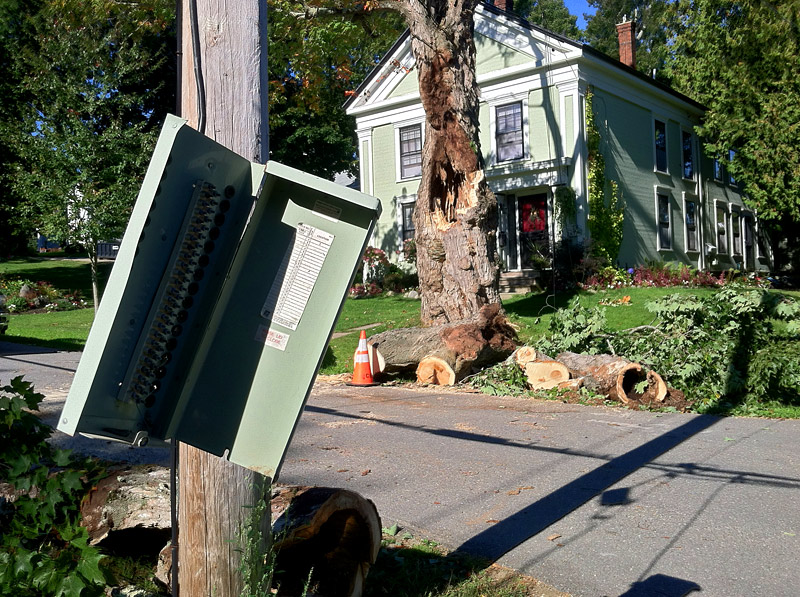Does Belfast love its trees too much?

BELFAST - In front of 81 Pearl Street, there’s an unremarkable horse chestnut tree.
According to Raymond Hall, who once lived there, it was planted his son to replace a “monster” oak cut down during a sweep for Dutch Elm disease. This was probably 40 years ago. The city had no tree warden then, and trees within the right-of-way were handled summarily by the city’s highway department.
“I went to the house for lunch one day and the tree was laying down across my walk,” Hall said.
He was surprised, but also certain that the workers had made a mistake.
“I think they intended to take down the one across Charles Street,” he said.
Hall told this story to the home’s current owner Liza Wheeler recently. On Tuesday, morning she pointed toward a scene that looked like the aftermath of a major storm. The massive sugar maple that dodged a bullet several decades earlier had lost a limb during a windy spell the day before. The branch — thick enough to be a sizable tree of its own, and now cut into pieces — had fallen across the street, yanking telecommunications wires down with it.
No one was hurt. But as Hall’s story of ‘the tree that got away’ suggests, the outcome could easily have been different.
A half mile away another major large maple tree lost a limb during the same storm.
Norman Tinker was outside his home at the corner of Miller and School Streets shortly after the last elementary school children passed his crossing guard station when he heard cracking noises coming from across the street. He watched the massive branch peel off and topple away from him, clipping the corner of his neighbor’s roof on the way down.
The neighbor, an 80-year-old woman who asked not to be named, was home when the limb fell. Her two-and-a-half year old great grandson was visiting and had just spotted the mail truck that parks near the house at the same time every day. When the woman looked up, she saw leaves traveling sideways past the window. Her first thought was for the safety of the mail carrier, who was, in that moment, trying to decide whether to run for the open field next to the house.
The homeowner and Tinker each described the moment as frightening, but neither was surprised that the limb fell. Nor were the workers who came to take down the rest of the tree on Tuesday morning. One of two companies on the scene had been there less than week before to remove a smaller branch. At that time, she said, a worker told her the whole tree should come down.
The information was useless by then. Like the tree on Pearl Street, the doomed maple stood within the city’s right-of-way — a margin extending 40-60 feet out from the center of all roadways, encompassing not only sidewalks and utility poles, but also shade trees and a fair number of front lawns. Any request to cut it down would likely have gone before the City Council, and in recent years, the Council has often taken pains not to cut down shade trees, sometimes going against the recommendations of its appointed tree wardens.
Caution would be justified in either case. In a span of 15 years, from 1959 to the mid-’70s, Dutch elm disease erased much of the stately canopy seen in historical photos. Other species were at the mercy of the highway department, stories like the one told by Ray Hall were common enough.
“You could have a four-foot [diameter] tree out in your yard and it would disappear when you were at work,” said City Councilor Mike Hurley. “That’s why we have a tree warden.”
Hurley helped create the advisory position while serving as mayor in 2003, and was the first to take the job. Since then, anyone who wants to remove or prune a tree within the city’s right of way has to talk to the tree warden first. The warden might consult an arborist on the condition and value of the tree. In some cases, the requests go before the City Council.
Hurley estimated that the city approves 80 to 90 percent of these, but old and highly visible trees often prompt lengthy discussions about alternatives.
“We err on the side of preserving trees. That’s a fact,” Hurley said. “But what we really need to be doing is proactive maintenance, and we’re not doing that.”
Hurley described the city’s approach to it’s trees as “totally reactive.” If someone comes forward, or something happens that calls attention to a tree, the city gets involved. There is no general oversight or budget for tree maintenance, he said.
“We don’t do any preventative pruning,” he said. “We keep talking about it, but we never do it.”
Didier Bonner-Ganter, a Belfast-based arborist who succeeded Hurley as tree warden, said the city’s process for addressing problems with its roadside trees has become more formal in recent years, possibly to a fault.
“Trees are beautiful, but the number one priority is public safety,” he said.
Bonner-Ganter said licensed arborists have a code of ethics that favors the trees they work on, but sometimes pruning is not enough and the tree has to be removed.
“That can be hard for people to swallow when it comes to a big tree coming down,” he said. “If they don’t understand the reasons it can be very emotional.”
An added complication in recent years has been shift in weather patterns toward more dramatic events like microbursts and extreme lightning storms. In those cases, he said, all bets are off:
“The science, the mechanics, that all gets thrown out the window.”
Ethan Andrews can be reached at news@penbaypilot.com




























